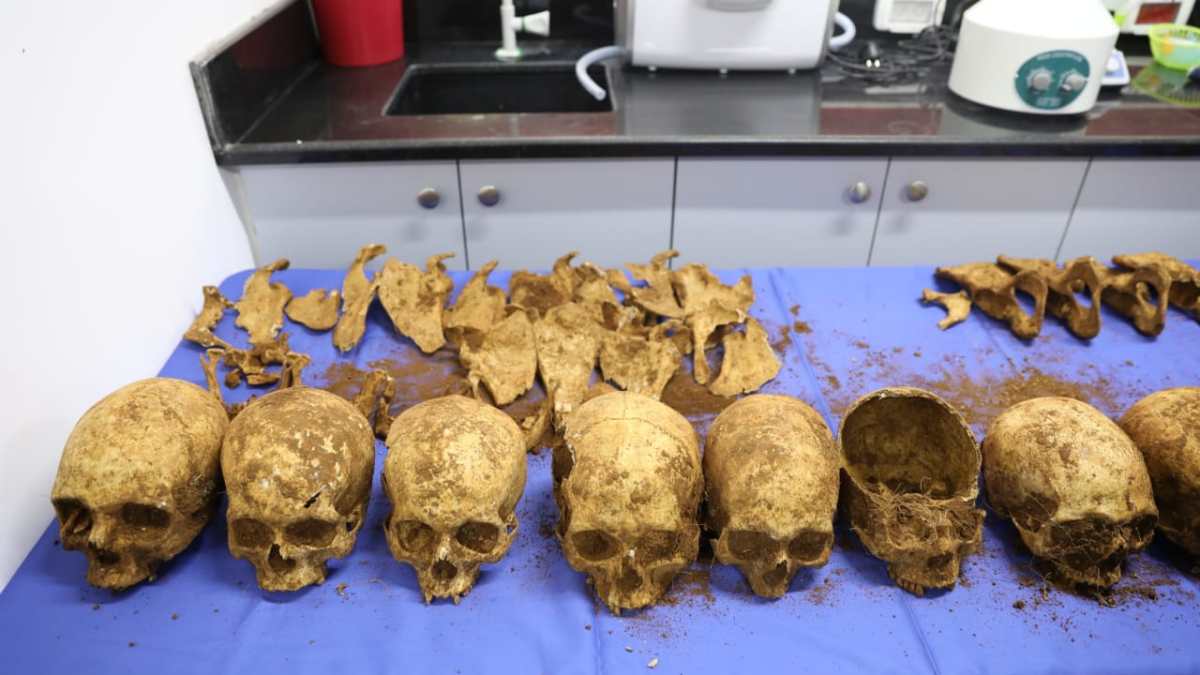Occupied Jerusalem - By sheer
coincidence, a Palestinian Bedouin farmer discovered a mass military grave containing the remains of 14 people in the mountain area of "Beit Hanina Al-Balad" located behind the separation wall, after he heard heavy barking dogs near his house.
The farmer saw a gathering of dogs on the farmland digging up the soil and pulling out bones from it. He called the Palestinian police, who in turn contacted the mayor of Beit Hanina, Mahmoud al-Najjar.
In his interview with Al-Jazeera Net, Al-Najjar said that he went to the mountain area, and there he saw a gathering of citizens with the police, who began collecting skulls and bones and documenting them with pictures.
The next day, the Palestinian police and a number of researchers went to the site and worked at the site for hours, before the occupation army stormed the area and prevented the completion of excavation and survey work, and closed it with warning red and white tape.
Al-Najjar confirmed that this is the first incident of its kind in Beit Hanina al-Balad, but he pointed out that some of the elderly who left had stories about the existence of a Jordanian army camp in the mountain area.
Preliminary evidence points to the remains of Ottoman, German or British soldiers (Jordanian Armed Forces General Command website)
German and Ottoman ammunition and uniforms
In turn, the researcher in the history and battles of the First World War in Palestine, Khaled Odeh Allah - who hails from the town of Beit Hanina - participated in the process of surveying and excavating the site of the discovered military mass grave.
And the return of God suggested, through a post and pictures he posted on his Facebook page, that the cemetery dates back to World War I, and that the skeletons belong to Ottoman or German soldiers, and it cannot be ruled out that it includes the remains of British soldiers as well.
Among the signs indicating the Ottoman-German identity of the soldiers - according to Odeh Allah - was the finding of a 5-shot magazine for the "Mauser" rifle next to the bodies, in addition to the buttons of a German or Ottoman military uniform with 3 holes, and cartridges of 92 x 57 mm German Ottoman Mauser made in 1915. and a German grenade stun grenade (Tortoise).
British guides
As for the signs indicating the British identity of the soldiers buried in the cemetery - according to the academic Ouda Allah - they are military uniform buttons with 4 holes, English cartridges, and a British ammunition clip made in 1917 for the main infantry rifle in the British army, "Lee Enfield". In the cemetery, a lead ball for a Charpenel shell was also found. Anti-personnel, which cannot be identified.
It is not possible - according to the return of God - with certainty that the cemetery contains the remains of English soldiers, because in many cases the Ottoman soldiers wore the uniforms of the dead English soldiers after their Ottoman military uniforms were worn out.
Regarding the exact date of the killing of the soldiers, there are two possibilities, the first: by artillery shelling during the first British attempt to cut off the Jerusalem-Nablus road in mid-November 1917, and the other: during the Ottoman-German counterattack in early December 1917 after the occupation of Jerusalem by the British on the eighth day from the same month.
A Jordanian team checks and follows up
Hours after the discovery of the military cemetery, the General Command of the Jordanian Armed Forces - the Arab Army issued a statement stating that the armed forces, in coordination with the Ministry of Foreign Affairs and Expatriate Affairs, are following up on the news of finding 15 remains believed to belong to Jordanian soldiers who were martyred in the town of "Hanina al-Tahta" north of Jerusalem during Battles fought by the Arab army in the June 1967 war.
An official military source in the Jordanian Armed Forces confirmed that a military team was sent in coordination with the concerned authorities to carry out the necessary checks to identify the remains, but it is too early to judge their identity for technical and medical reasons that require more laboratory tests, noting that the results of any examinations or efforts show The identity of the remains will be announced later.
Jordan announced sending a delegation to examine the remains discovered in the mass grave (Jordanian Armed Forces General Command website)
Forensic medicine: We examine the remains
In turn, the Palestinian Public Prosecution office initiated investigation procedures, while the police began research and investigation procedures into the incident.
In a report published on the website of the Palestinian police, the media spokesman for the police, Colonel Louay Irzeikat, stated that the prosecution ordered the transfer of the remains to the Institute of Forensic Medicine to complete the necessary procedures in this regard.
According to the Applied Research Institute - Jerusalem (ARIJ), Beit Hanina Al-Balad classified its lands as “B” and “C”, and its area is estimated at 4,187 dunums, of which 1,629 are arable and 250 are residential.
The population is estimated at 1,700 people, according to the mayor, Mahmoud Al-Najjar, who concluded his speech to Al-Jazeera Net by saying that the basin in which the mass grave No. Abu sane.

